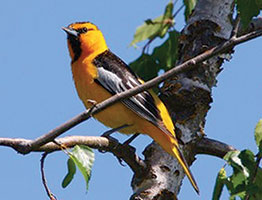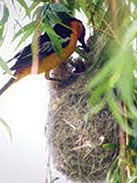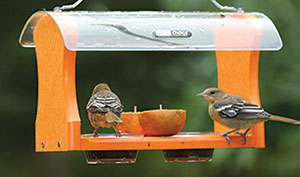
Oriole Fans Get Ready!
Posted by Grange Co-op on 24th Oct 2013
 The Bullock’s Orioles are due back anytime now. The first sighting at my house last spring was on May 4th. When I hear a medium-pitched 2-note whistle and a rapid chatter that stands out from the other birds singing in my yard, I start looking around. Both the female and male sing, though they have slightly different endings to their songs. This beautiful yellow-orange and black bird with a bold white wing patch is actually a member of the blackbird family, the Icterids. They are summer breeding residents here in southern Oregon, spending their winters in southern California and Mexico. Orioles are birds of riparian and open woodlands with tall trees. They are most common in western Oregon where cottonwood trees grow alongside rivers, streams, and other wetlands. The Bullock’s is the only oriole that visits southern Oregon.
The Bullock’s Orioles are due back anytime now. The first sighting at my house last spring was on May 4th. When I hear a medium-pitched 2-note whistle and a rapid chatter that stands out from the other birds singing in my yard, I start looking around. Both the female and male sing, though they have slightly different endings to their songs. This beautiful yellow-orange and black bird with a bold white wing patch is actually a member of the blackbird family, the Icterids. They are summer breeding residents here in southern Oregon, spending their winters in southern California and Mexico. Orioles are birds of riparian and open woodlands with tall trees. They are most common in western Oregon where cottonwood trees grow alongside rivers, streams, and other wetlands. The Bullock’s is the only oriole that visits southern Oregon.
 Orioles are well known for their hanging sock-like nests which the female weaves and suspends on the fine outer branches of deciduous trees, 6-60 ft. high. This delicate location makes it difficult for larger predators to reach the nest. Though the nests are built new each year, they are often built in the same tree or even the same part of the tree as the year before. The nests are neatly woven of hair, (especially horsehair), twine, plant fibers, grasses, and wool. They are lined with cottonwood or willow cotton, wool, or feathers. Orioles will incorporate yarn and thread into the nest if these items are offered at the time of nest building. (Try putting some nesting material out in a suet basket for the spring nesting season.) When the nest is complete, it cradles a clutch of 4-5 eggs which the female will incubate for about two weeks. Both parents share the duties of raising the brood. The young leave the nest when they are about two weeks old. Unlike many birds, orioles only raise a single brood each year.
Orioles are well known for their hanging sock-like nests which the female weaves and suspends on the fine outer branches of deciduous trees, 6-60 ft. high. This delicate location makes it difficult for larger predators to reach the nest. Though the nests are built new each year, they are often built in the same tree or even the same part of the tree as the year before. The nests are neatly woven of hair, (especially horsehair), twine, plant fibers, grasses, and wool. They are lined with cottonwood or willow cotton, wool, or feathers. Orioles will incorporate yarn and thread into the nest if these items are offered at the time of nest building. (Try putting some nesting material out in a suet basket for the spring nesting season.) When the nest is complete, it cradles a clutch of 4-5 eggs which the female will incubate for about two weeks. Both parents share the duties of raising the brood. The young leave the nest when they are about two weeks old. Unlike many birds, orioles only raise a single brood each year.
The Bullock’s Orioles eat insects, fruit, and nectar. Among their favorite insect foods are hairy caterpillars, such as tent caterpillars. Though most birds avoid hairy caterpillars because they are difficult to swallow (not that I’ve tried mind you), orioles and tanagers don’t let a few nasty
 hairs discourage them.They hold hairy caterpillars in their bill and whack them against a branch until most of the hairs fall off. Then it’s down the hatch!They will visit nectar feeders as well as fruit and jelly feeders. Be sure to get your feeders out ahead of their scheduled appearance so you don’t miss them.Otherwise, they may just pass you by. Often orioles will try to sip nectar from hummingbird feeders, but being so much larger than hummingbirds they have a difficult time using these feeders and getting a free meal becomes a frustrating experience. To make it easier for orioles to get a backyard snack (and be more apt to stick around), consider using a feeder designed especially for them. The nectar feeders are orange (a color orioles associate with), and have feeding ports and perches that are larger to fit their larger bodies. I would also encourage you to put out grape jelly.
hairs discourage them.They hold hairy caterpillars in their bill and whack them against a branch until most of the hairs fall off. Then it’s down the hatch!They will visit nectar feeders as well as fruit and jelly feeders. Be sure to get your feeders out ahead of their scheduled appearance so you don’t miss them.Otherwise, they may just pass you by. Often orioles will try to sip nectar from hummingbird feeders, but being so much larger than hummingbirds they have a difficult time using these feeders and getting a free meal becomes a frustrating experience. To make it easier for orioles to get a backyard snack (and be more apt to stick around), consider using a feeder designed especially for them. The nectar feeders are orange (a color orioles associate with), and have feeding ports and perches that are larger to fit their larger bodies. I would also encourage you to put out grape jelly.
They loved the Birdberry jelly, (a jelly mix of grape and blackberry made especially for the birds), which I offered them last year. Not only will the orioles love it, but you’ll find the black-headed grosbeaks will love it too! Orange halves would also be a nice addition. You might find western tanagers eating the oranges along with the orioles. Mealworms would also be a great offering. You can offer the mealworms in the same type of dish feeder you offer jelly. Our Wild Bird Country departments have a great selection of nectar, jelly and mealworm feeders.
